Trends in Ecosystem Services across Europe Due to Land-Use/Cover Changes
Abstract
:1. Introduction
2. Materials and Methods
- Aggregating LULC types: We used the CORINE Land Cover (CLC) [53,54] in grid format with a spatial resolution of 100 × 100 m to map ES values across Europe for 2000 and 2018. To assign ES values to LULC types, we aggregated the 44 CLC classes into 11 major LULC types (Table A1). These 11 LULC types mostly correspond to the second level of thematic detail according to the hierarchical nomenclature of CLC [53,54]. Settlement areas and wetlands were aggregated at the first thematic level of CLC.
- Attributing ES values: We generated maps for each ES and both time steps (2000 and 2018) by attributing ES values to the respective LULC type (Table A2). Since some LULC types were missing in Tasser et al. [7], we integrated ES values from other studies [52,55,56]. Moreover, we distinguished raster cells with slope < and ≥30° for a refined mapping of protection from hazards (R1) by adapting ES supply [57,58] and set the sociocultural preference to 1 in areas with a slope below 30°, as there is no demand for this ES. The resulting ES maps had high spatial resolutions (100 × 100 m) and needed to be converted to a coarser scale to depict trends at the European level. We used a map of European ecological regions [59] (henceforth referred as ecoregions) at a scale of 1:2.5 million (Figure A1) to calculate area-weighted mean values for each ES and each ecoregion from the fine-scale raster maps. The ecoregions represent relatively homogeneous ecological conditions and were delimited based on climatic, topographic and geobotanical data by a large team of experts from several European nature-related institutions and the WWF [59].
- Cluster analysis: Due to the high number of ecoregions (n = 52), we applied cluster analysis to group ecoregions with similar LULC composition as well as similar LULC changes. We applied hierarchical cluster analysis in SPSS Statistics (version 26, IBM, Armonk, NY, USA) using the squared Euclidean distance to measure the dissimilarity of the variables and applied Ward’s linkage method to aggregate the clusters.
- Analysing impacts: To depict characteristics and trends in LULC and ES values at the ecoregional level, we first calculated area-weighted mean values of LULC types and ES values for each ecoregion and each cluster based on the raster maps (generated in steps 1 and 2). Changes in LULC and ES values between 2000 and 2018 were then derived for each ecoregion by calculating the differences between the two time steps.
3. Results
3.1. Spatial Patterns and Trends in ES Values
3.2. Regions with Similar LULC
3.3. Change Patterns in ES Values
4. Discussion
4.1. General and Specific Trends in ES Values in Relation to LULC Changes
4.2. Limitations and Future Prospects
5. Conclusions
Author Contributions
Funding
Institutional Review Board Statement
Informed Consent Statement
Data Availability Statement
Conflicts of Interest
Appendix A
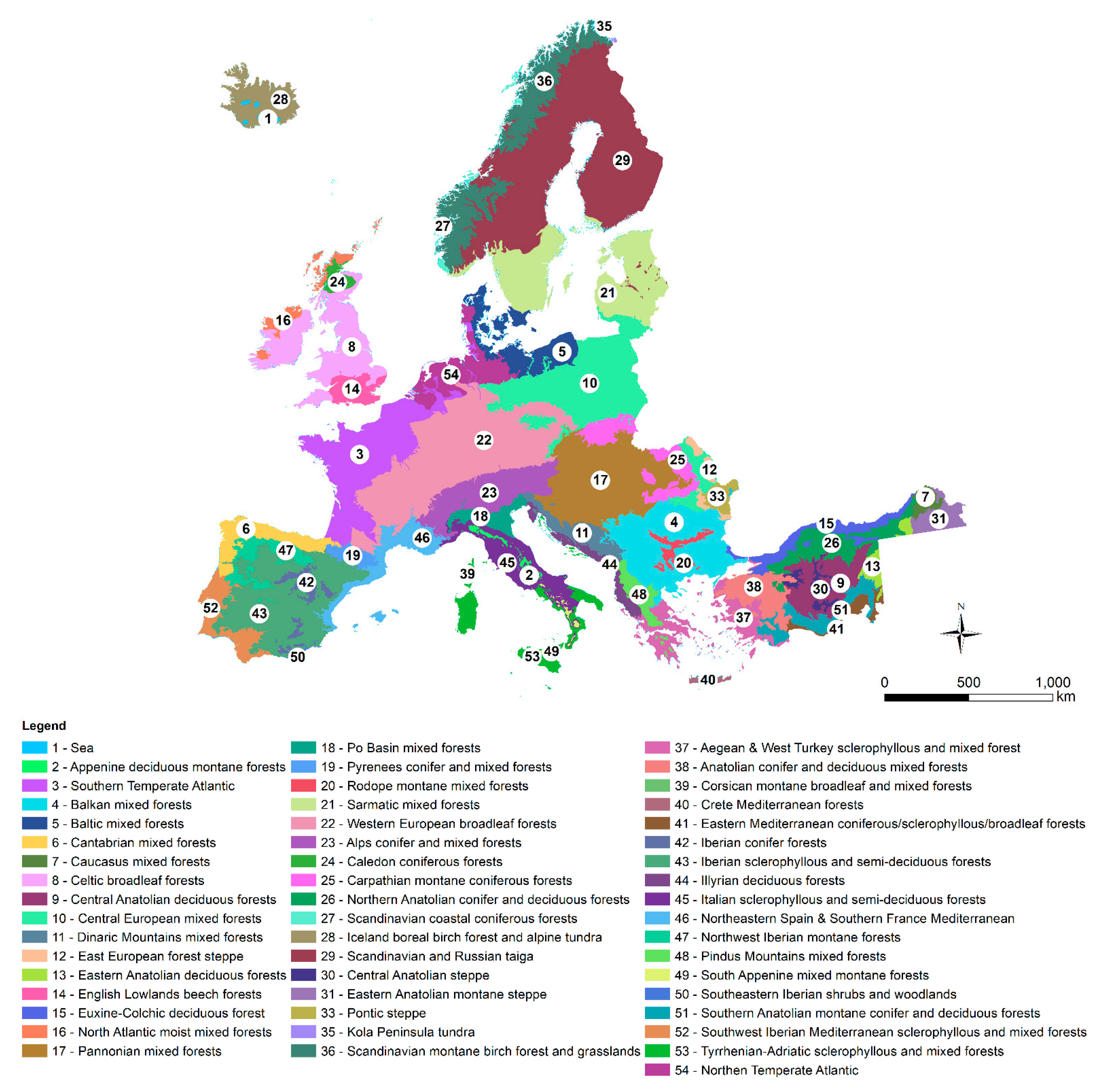
| LULC Type | CLC Classes |
|---|---|
| Settlement area | 111, 112, 121, 122, 123, 124, 131, 132, 133, 141, 142 |
| Crop cultivation | 211, 212, 213, 241 |
| Permanent culture | 221, 222, 223 |
| Fertilised grassland | 231, 242, 243, 244 |
| Unfertilised grassland | 321, 333 |
| Forest | 311, 312, 313 |
| Shrubs | 322, 323, 324 |
| Open spaces | 331, 332, 334, 335 |
| Wetlands | 411, 412, 421, 422, 423 |
| Rivers | 511 |
| Lakes | 512, 521, 522, 523 |
| ES | Settlement Area | Crop Cultivation | Permanent Culture | Fertilised Grassland | Unfertilised Grassland | Forest | Shrubs | Open Spaces | Wetlands | Rivers | Lakes | Socio-Cultural Preference |
|---|---|---|---|---|---|---|---|---|---|---|---|---|
| Pasture and fodder production (P1) | 0.00 a | 0.86 h | 0.85 h | 4.04 h | 2.23 h | 0.77 h | 1.06 h | 0.00 a | 0.77 a | 0.00 a | 0.00 a | 4.15 h |
| Agricultural food production (P2) | 0.00 a | 2.06 h | 2.86 h | 0.00 h | 0.00 h | 0.00 h | 0.00 h | 0.00 a | 0.00 a | 0.00 a | 0.00 a | 4.29 h |
| Timber production (P3) | 0.00 a | 0.00 h | 2.18 h | 0.02 h | 0.67 h | 4.53 h | 1.66 h | 0.00 a | 1.66 a | 1.66 a | 0.00 a | 4.18 h |
| Gathering mushrooms and wild berries (P4) | 0.00 a | 0.10 h | 0.17 h | 0.45 h | 0.97 h | 4.18 h | 1.77 h | 0.00 a | 1.77 a | 0.00 a | 0.00 a | 4.19 h |
| Provision of clean drinking water (P5) | 0.29 b | 1.19 h | 1.81 h | 2.39 h | 3.91 h | 4.09 h | 4.43 h | 3.98 b | 3.95 b | 4.03 b | 4.03 b | 4.52 h |
| Protection from hazards (R1a), slope <30° | 0.00 a | 0.30 a | 0.69 a | 0.73 a | 0.79 a | 0.94 a | 0.54 a | 0.30 i | 0.54 i | 2.50 i | 3.00 i | 1.00 h |
| Protection from hazards (R1b), slope >30° | 0.00 a | 1.27 h | 2.93 h | 3.13 h | 3.38 h | 4.00 h | 2.30 h | 1.00 i | 1.90 i | 2.50 i | 3.00 i | 4.27 h |
| Prevention of water scarcity (R2) | 3.03 c | 2.40 h | 2.46 h | 4.09 h | 4.34 h | 3.72 h | 4.34 h | 4.10 c | 1.56 c | 3.90 c | 3.90 c | 4.45 h |
| Provision of habitats (R3) | 2.63 d | 1.77 h | 1.97 h | 2.20 h | 3.71 h | 3.67 h | 3.38 h | 1.14 d | 3.39 d | 2.25 d | 0.25 d | 4.61 h |
| Maintaining biodiversity (R4) | 2.34 d | 1.95 h | 1.72 h | 2.13 h | 3.41 h | 3.03 h | 2.72 h | 1.01 d | 3.01 d | 2.00 d | 0.22 d | 4.26 h |
| Providing habitats for pollinating insects (R5) | 2.37 d | 1.40 h | 1.40 h | 2.47 h | 3.64 h | 2.99 h | 3.21 h | 1.03 d | 3.06 d | 2.03 | 0.23 d | 4.20 h |
| Pest control (R6) | 2.47 d | 1.88 h | 2.72 h | 2.78 h | 3.12 h | 3.21 h | 2.62 h | 1.07 d | 3.19 d | 2.11 d | 0.24 d | 3.72 h |
| Disease control (R7) | 2.64 d | 2.42 h | 2.77 h | 3.11 h | 3.24 h | 3.26 h | 2.92 h | 1.14 d | 3.41 d | 2.26 d | 0.25 d | 4.01 h |
| Maintenance or increase of soil fertility (R8) | 0.00 a | 1.98 h | 2.29 h | 2.77 h | 2.37 h | 2.48 h | 2.57 h | 1.49 i | 1.98 i | 2.47 i | 3.46 i | 3.64 h |
| Positive effect on the climate (R9) | 1.30 e | 1.29 h | 2.37 h | 2.11 h | 2.28 h | 4.11 h | 2.69 h | 1.85 e | 5.00 e | 1.08 e | 1.08 e | 4.38 h |
| Opportunities for leisure activities (C1) | 2.64 f | 2.83 h | 2.41 h | 3.58 h | 4.55 h | 3.60 h | 3.56 h | 3.92 f | 2.43 f | 3.49 f | 3.79 f | 4.59 h |
| Attractive housing and living space (C2) | 1.76 a | 2.30 h | 1.35 h | 2.56 h | 2.61 h | 1.91 h | 2.16 h | 0.00 a | 1.67 a | 2.14 a | 2.27 a | 3.04 h |
| Experience of animals & plants (C3) | 0.79 f | 1.65 h | 1.54 h | 2.15 h | 3.21 h | 3.26 h | 3.16 h | 3.56 f | 2.47 f | 3.72 f | 3.68 f | 4.46 h |
| Aesthetic inspiration (C4) | 2.56 f | 3.06 h | 2.45 h | 3.30 h | 3.82 h | 3.63 h | 3.55 h | 3.15 f | 2.99 f | 4.31 f | 4.66 f | 4.35 h |
| Cultural heritage (C5) | 3.86 f | 2.82 h | 2.83 h | 3.16 h | 3.59 h | 3.24 h | 3.75 h | 2.43 f | 1.59 f | 2.43 f | 2.34 f | 4.25 h |
| Provisioning ES | 0.06 g | 0.84 g | 1.57 g | 1.38 g | 1.56 g | 2.71 g | 1.78 g | 0.80 g | 1.63 g | 1.14 g | 0.81 g | |
| Regulating ES | 1.87 g | 1.71 g | 2.04 g | 2.49 g | 2.99 g | 3.05 g | 2.78 g | 1.46 g | 2.79 g | 2.29 g | 1.40 g | |
| Cultural ES | 2.32 g | 2.53 g | 2.12 g | 2.95 g | 3.56 g | 3.13 g | 3.24 g | 2.61 g | 2.23 g | 3.22 g | 3.35 g |
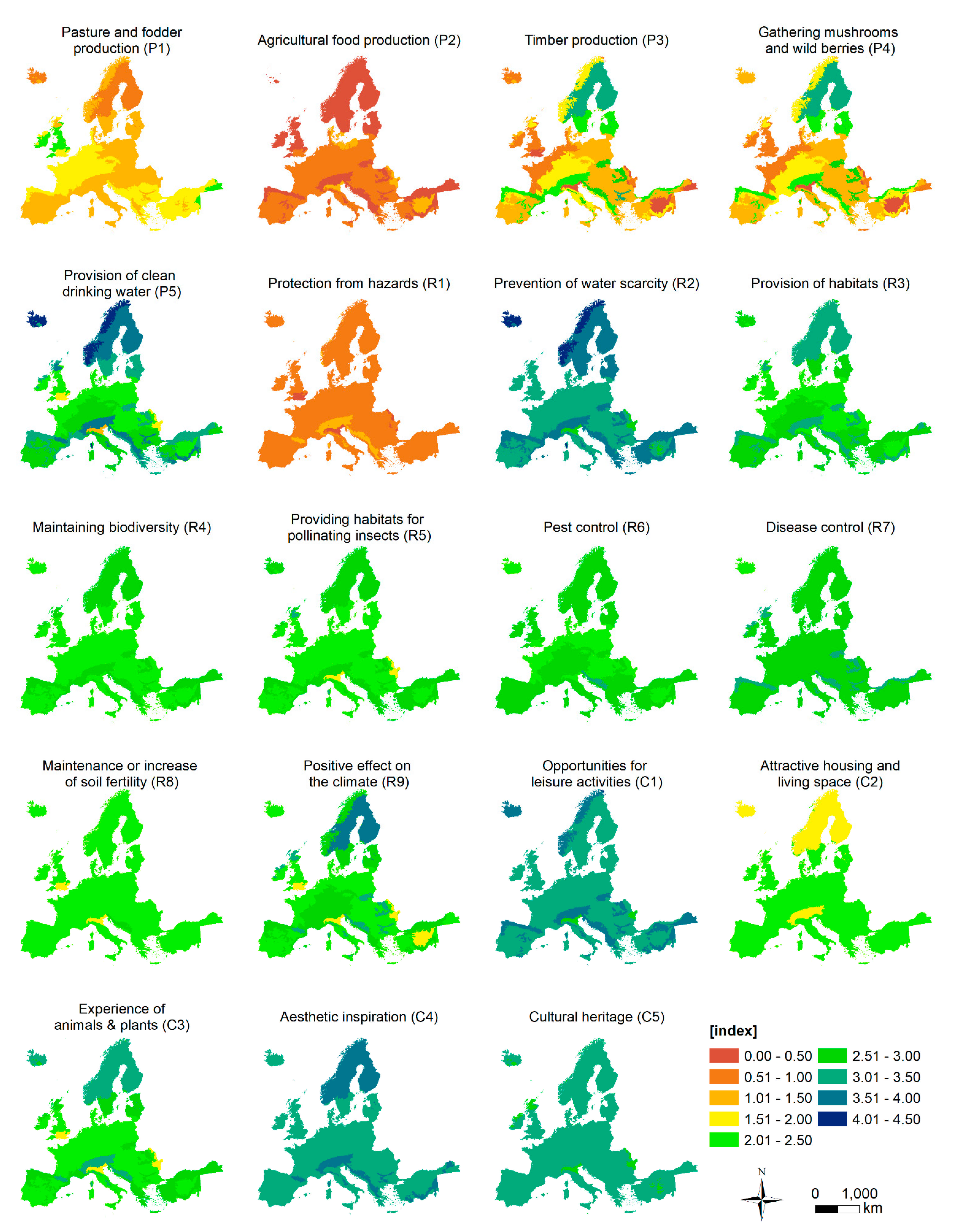
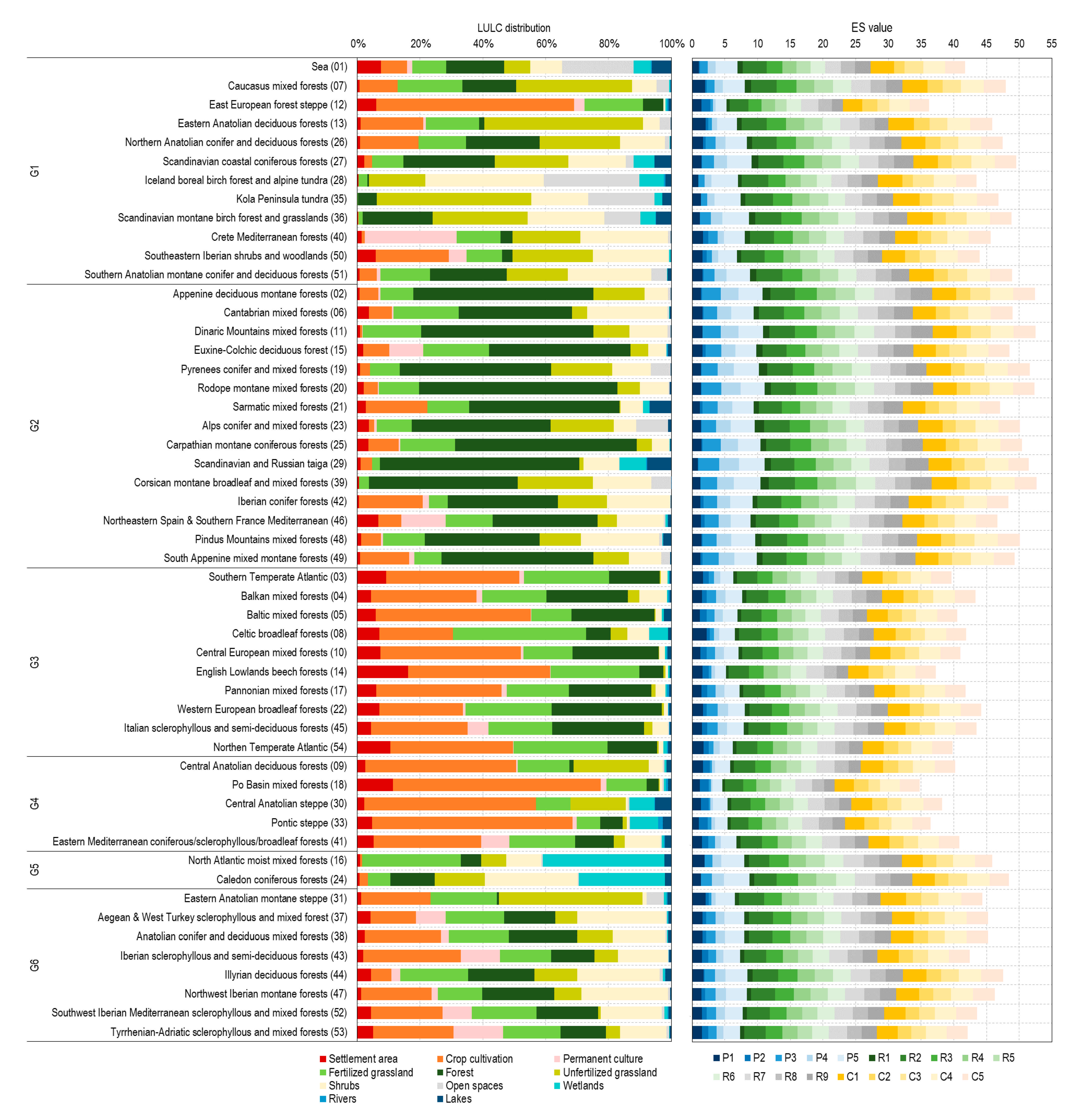
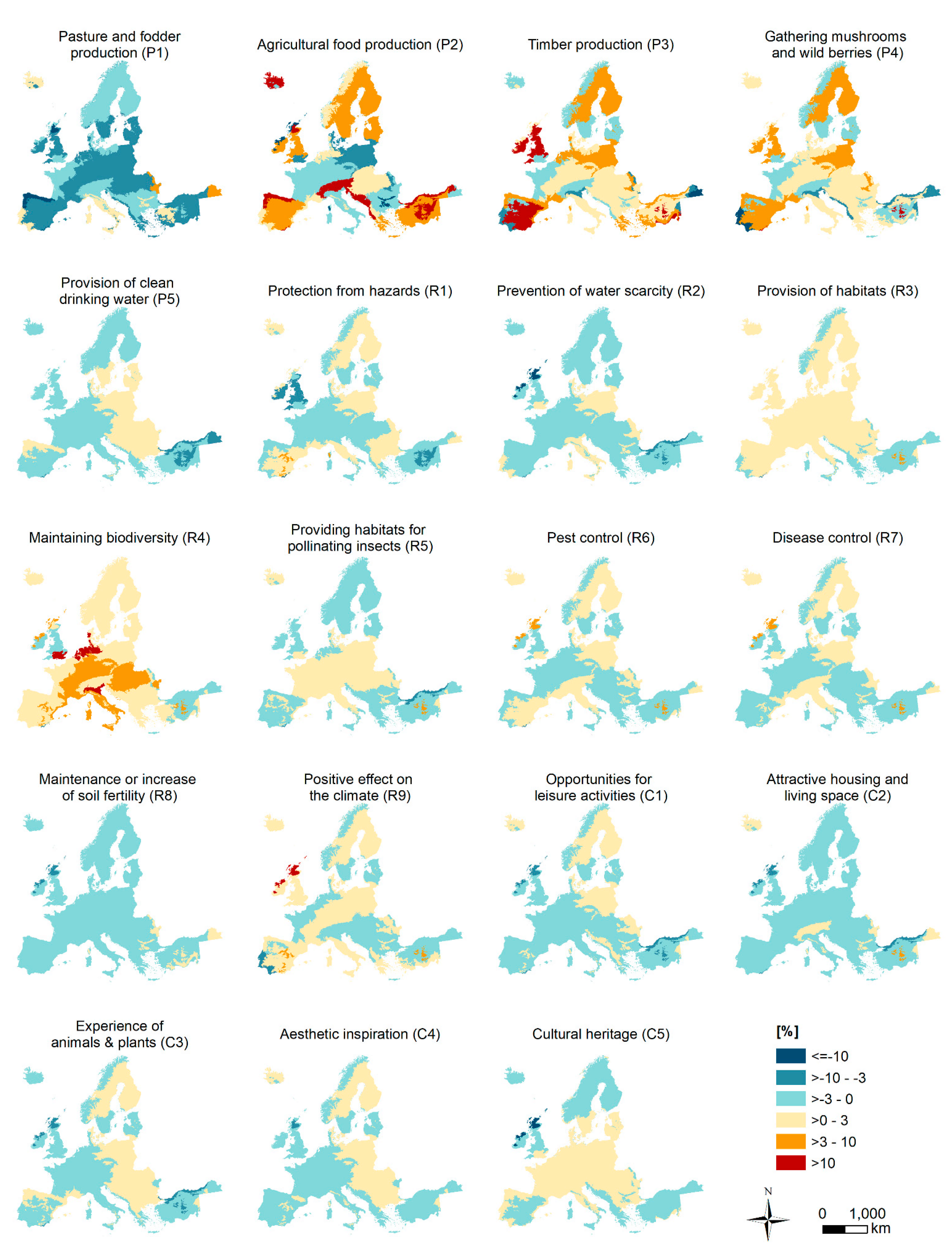
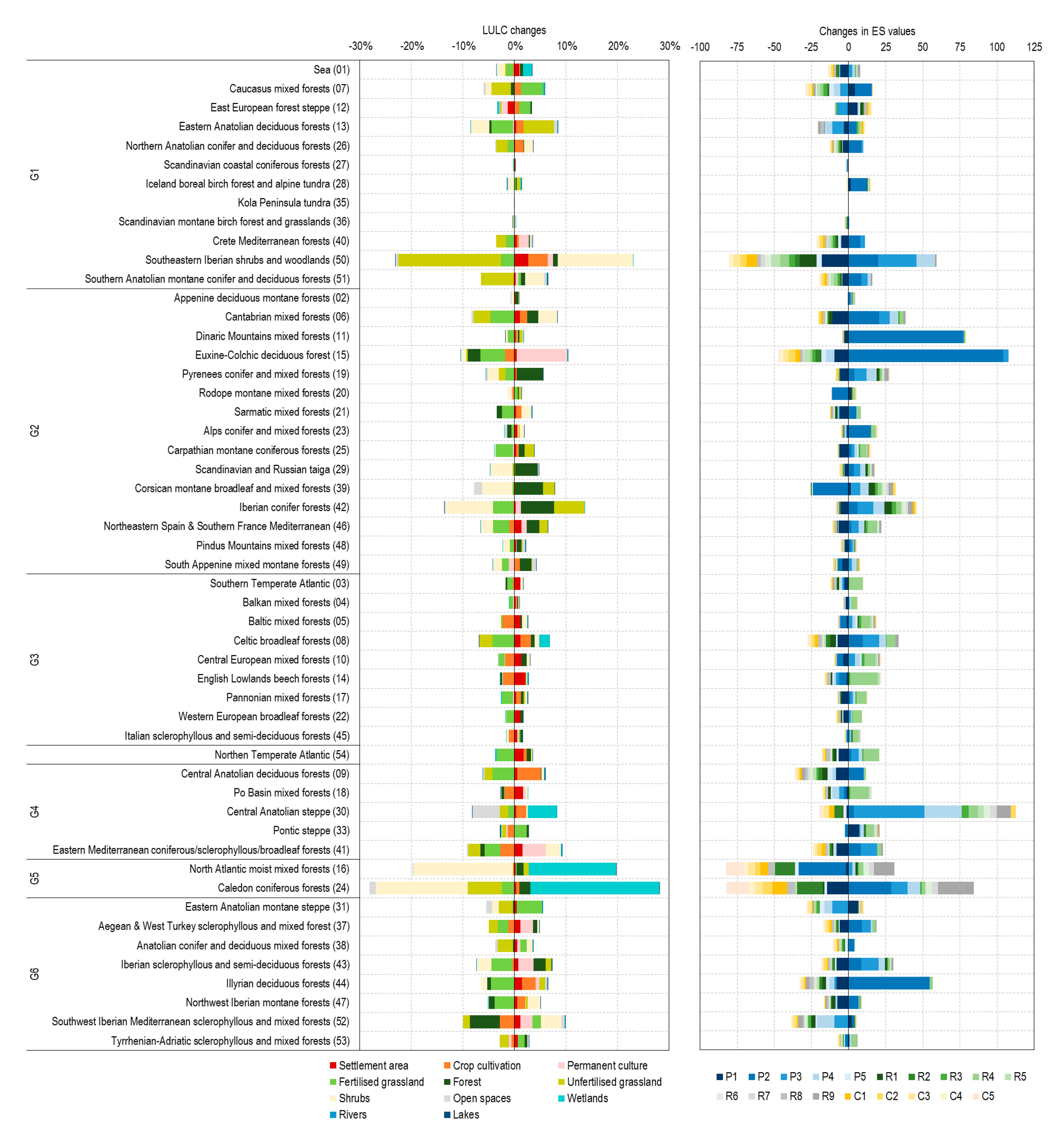



References
- De Groot, R.S.; Alkemade, R.; Braat, L.; Hein, L.; Willemen, L. Challenges in integrating the concept of ecosystem services and values in landscape planning, management and decision making. Ecol. Complex. 2010, 7, 260–272. [Google Scholar] [CrossRef]
- Egarter Vigl, L.; Schirpke, U.; Tasser, E.; Tappeiner, U. Linking long-term landscape dynamics to the multiple interactions among ecosystem services in the European Alps. Landsc. Ecol. 2016, 31, 1903–1918. [Google Scholar] [CrossRef] [Green Version]
- Stürck, J.; Schulp, C.J.E.; Verburg, P.H. Spatio-temporal dynamics of regulating ecosystem services in Europe—The role of past and future land use change. Appl. Geogr. 2015, 63, 121–135. [Google Scholar] [CrossRef]
- Metzger, M.J.; Rounsevell, M.D.A.; Acosta-Michlik, L.; Leemans, R.; Schröter, D. The vulnerability of ecosystem services to land use change. Agric. Ecosyst. Environ. 2006, 114, 69–85. [Google Scholar] [CrossRef]
- Polce, C.; Maes, J.; Brander, L.; Cescatti, A.; Baranzelli, C.; Lavalle, C.; Zulian, G. Global change impacts on ecosystem services: A spatially explicit assessment for Europe. One Ecosyst. 2016, 1, e9990. [Google Scholar] [CrossRef] [Green Version]
- Lavorel, S.; Grigulis, K.; Leitinger, G.; Kohler, M.; Schirpke, U.; Tappeiner, U. Historical trajectories in land use pattern and grassland ecosystem services in two European alpine landscapes. Reg. Environ. Chang. 2017, 17, 2251–2264. [Google Scholar] [CrossRef]
- Tasser, E.; Schirpke, U.; Zoderer, B.M.; Tappeiner, U. Towards an integrative assessment of land-use type values from the perspective of ecosystem services. Ecosyst. Serv. 2020, 42, 101082. [Google Scholar] [CrossRef]
- Spake, R.; Lasseur, R.; Crouzat, E.; Bullock, J.M.; Lavorel, S.; Parks, K.E.; Schaafsma, M.; Bennett, E.M.; Maes, J.; Mulligan, M.; et al. Unpacking ecosystem service bundles: Towards predictive mapping of synergies and trade-offs between ecosystem services. Glob. Environ. Chang. 2017, 47, 37–50. [Google Scholar] [CrossRef] [Green Version]
- Falcucci, A.; Maiorano, L.; Boitani, L. Changes in land-use/land-cover patterns in Italy and their implications for biodiversity conservation. Landsc. Ecol. 2007, 22, 617–631. [Google Scholar] [CrossRef]
- Xystrakis, F.; Psarras, T.; Koutsias, N. A process-based land use/land cover change assessment on a mountainous area of Greece during 1945–2009: Signs of socio-economic drivers. Sci. Total Environ. 2017, 587–588, 360–370. [Google Scholar] [CrossRef]
- García-Nieto, A.P.; Geijzendorffer, I.R.; Baró, F.; Roche, P.K.; Bondeau, A.; Cramer, W. Impacts of urbanization around Mediterranean cities: Changes in ecosystem service supply. Ecol. Indic. 2018, 91, 589–606. [Google Scholar] [CrossRef] [Green Version]
- Balzan, M.V.; Sadula, R.; Scalvenzi, L. Assessing Ecosystem Services Supplied by Agroecosystems in Mediterranean Europe: A Literature Review. Land 2020, 9, 245. [Google Scholar] [CrossRef]
- Guo, Z.; Zhang, L.; Li, Y. Increased dependence of humans on ecosystem services and biodiversity. PLoS ONE 2010, 5. [Google Scholar] [CrossRef]
- Buckley, R.; Gretzel, U.; Scott, D.; Weaver, D.; Becken, S. Tourism megatrends. Tour. Recreat. Res. 2015, 40, 59–70. [Google Scholar] [CrossRef] [Green Version]
- Marando, F.; Salvatori, E.; Sebastiani, A.; Fusaro, L.; Manes, F. Regulating Ecosystem Services and Green Infrastructure: Assessment of Urban Heat Island effect mitigation in the municipality of Rome, Italy. Ecol. Modell. 2019, 392, 92–102. [Google Scholar] [CrossRef]
- Schröter, D.; Cramer, W.; Leemans, R.; Prentice, I.C.; Araújo, M.B.; Arnell, N.W.; Bondeau, A.; Bugmann, H.; Carter, T.R.; Gracia, C.A.; et al. Ecosystem Service Supply and Vulnerability to Global Change in Europe. Science 2005, 310, 1333–1337. [Google Scholar] [CrossRef] [Green Version]
- Bouwma, I.; Schleyer, C.; Primmer, E.; Winkler, K.J.; Berry, P.; Young, J.; Carmen, E.; Špulerová, J.; Bezák, P.; Preda, E.; et al. Adoption of the ecosystem services concept in EU policies. Ecosyst. Serv. 2018, 29, 213–222. [Google Scholar] [CrossRef]
- European Commission Green Infrastructure (GI)—Enhancing Europe’s Natural Capital. Communication from the Commission to the European Parliament, the Council, the European Economic and Social Committee and the Committee of the Regions. COM/2013/0249 Final. Available online: https://eur-lex.europa.eu/legal-content/EN/TXT/?uri=CELEX:52013DC0249 (accessed on 5 May 2021).
- European Commission EU Biodiversity Strategy for 2030. Bringing Nature Back into Our Lives. Communication from the Commission to the European Parliament, the Council, the European Economic and Social Committee and the Committee of the Regions. COM/2020/380 Final. Available online: https://eur-lex.europa.eu/legal-content/EN/TXT/?uri=CELEX:52020DC0380 (accessed on 5 May 2021).
- European Commission A New EU Forest Strategy: For Forests and the Forest-Based Sector. Communication from the Commission. COM/2013/0659 Final. Available online: https://eur-lex.europa.eu/legal-content/EN/TXT/?qid=1564480895507&uri=CELEX:52013DC0659 (accessed on 5 May 2021).
- European Commission Regulation (EU) No 1143/2014 of the European Parliament and of the Council of 22 October 2014 on the Prevention and Management of the Introduction and Spread of Invasive Alien Species. Available online: https://eur-lex.europa.eu/legal-content/EN/TXT/?uri=CELEX%3A02014R1143-20191214 (accessed on 5 May 2021).
- European Commission the Common Agricultural Policy at a Glance. Available online: https://ec.europa.eu/info/food-farming-fisheries/key-policies/common-agricultural-policy/cap-glance_en (accessed on 6 May 2021).
- European Commission Directive 2000/60/EC of the European Parliament and of the Council of 23 October 2000 Establishing a Framework for Community Action in the Field of Water Policy. Available online: https://eur-lex.europa.eu/legal-content/EN/TXT/?uri=CELEX%3A02000L0060-20141120 (accessed on 6 May 2021).
- Guy, P.; Birkenstock, M.; Lakner, S.; Röder, N. The Common Agricultural Policy post-2020: Views and Recommendations from Scientists to improve performance for biodiversity Volume 1—Synthesis Report; Thünen Working Paper; Johann Heinrich von Thuenen-Institut (vTI), Federal Research Institute for Rural Areas, Forestry and Fisheries: Braunschweig, Germany, 2021. [Google Scholar]
- European Commission Missions in Horizon Europe. Available online: https://ec.europa.eu/info/research-and-innovation/funding/funding-opportunities/funding-programmes-and-open-calls/horizon-europe/missions-horizon-europe_en (accessed on 14 June 2021).
- Burkhard, B.; Maes, J. (Eds.) Mapping Ecosystem Services; Pensoft Publishers: Sofia, Bulgaria, 2017. [Google Scholar]
- Maes, J.; Liquete, C.; Teller, A.; Erhard, M.; Paracchini, M.L.; Barredo, J.I.; Grizzetti, B.; Cardoso, A.; Somma, F.; Petersen, J.-E.; et al. An indicator framework for assessing ecosystem services in support of the EU Biodiversity Strategy to 2020. Ecosyst. Serv. 2016, 17, 14–23. [Google Scholar] [CrossRef] [Green Version]
- Schulp, C.J.E.; Van Teeffelen, A.J.A.; Tucker, G.; Verburg, P.H. A quantitative assessment of policy options for no net loss of biodiversity and ecosystem services in the European Union. Land Use Policy 2016, 57, 151–163. [Google Scholar] [CrossRef]
- Vallecillo, S.; Polce, C.; Barbosa, A.; Perpiña Castillo, C.; Vandecasteele, I.; Rusch, G.M.; Maes, J. Spatial alternatives for Green Infrastructure planning across the EU: An ecosystem service perspective. Landsc. Urban. Plan. 2018, 174, 41–54. [Google Scholar] [CrossRef]
- Turkelboom, F.; Leone, M.; Jacobs, S.; Kelemen, E.; García-Llorente, M.; Baró, F.; Termansen, M.; Barton, D.N.; Berry, P.; Stange, E.; et al. When we cannot have it all: Ecosystem services trade-offs in the context of spatial planning. Ecosyst. Serv. 2018, 29, 566–578. [Google Scholar] [CrossRef]
- Schirpke, U.; Candiago, S.; Egarter Vigl, L.; Jäger, H.; Labadini, A.; Marsoner, T.; Meisch, C.; Tasser, E.; Tappeiner, U. Integrating supply, flow and demand to enhance the understanding of interactions among multiple ecosystem services. Sci. Total Environ. 2019, 651, 928–941. [Google Scholar] [CrossRef] [PubMed]
- Cord, A.F.; Bartkowski, B.; Beckmann, M.; Dittrich, A.; Hermans-Neumann, K.; Kaim, A.; Lienhoop, N.; Locher-Krause, K.; Priess, J.; Schröter-Schlaack, C.; et al. Towards systematic analyses of ecosystem service trade-offs and synergies: Main concepts, methods and the road ahead. Ecosyst. Serv. 2017, 28, 264–272. [Google Scholar] [CrossRef]
- Schrama, M.; de Haan, J.J.; Kroonen, M.; Verstegen, H.; Van der Putten, W.H. Crop yield gap and stability in organic and conventional farming systems. Agric. Ecosyst. Environ. 2018, 256, 123–130. [Google Scholar] [CrossRef]
- Schirpke, U.; Tscholl, S.; Tasser, E. Spatio-temporal changes in ecosystem service values: Effects of land-use changes from past to future (1860–2100). J. Environ. Manag. 2020, 272, 111068. [Google Scholar] [CrossRef] [PubMed]
- Ala-Hulkko, T.; Kotavaara, O.; Alahuhta, J.; Hjort, J. Mapping supply and demand of a provisioning ecosystem service across Europe. Ecol. Indic. 2019, 103, 520–529. [Google Scholar] [CrossRef]
- Schirpke, U.; Tappeiner, U.; Tasser, E. A transnational perspective of global and regional ecosystem service flows from and to mountain regions. Sci. Rep. 2019, 9, 6678. [Google Scholar] [CrossRef] [PubMed] [Green Version]
- González-García, A.; Palomo, I.; González, J.A.; López, C.A.; Montes, C. Quantifying spatial supply-demand mismatches in ecosystem services provides insights for land-use planning. Land Use Policy 2020, 94, 104493. [Google Scholar] [CrossRef]
- Laroche, P.C.S.J.; Schulp, C.J.E.; Kastner, T.; Verburg, P.H. Telecoupled environmental impacts of current and alternative Western diets. Glob. Environ. Chang. 2020, 62, 102066. [Google Scholar] [CrossRef]
- Hauck, J.; Görg, C.; Varjopuro, R.; Ratamäki, O.; Maes, J.; Wittmer, H.; Jax, K. “Maps have an air of authority”: Potential benefits and challenges of ecosystem service maps at different levels of decision making. Ecosyst. Serv. 2013, 4, 25–32. [Google Scholar] [CrossRef]
- Paprotny, D.; Terefenko, P.; Giza, A.; Czapliński, P.; Vousdoukas, M.I. Future losses of ecosystem services due to coastal erosion in Europe. Sci. Total Environ. 2021, 760, 144310. [Google Scholar] [CrossRef]
- Grunewald, K.; Syrbe, R.-U.; Walz, U.; Richter, B.; Meinel, G.; Herold, H.; Marzelli, S. Germany’s Ecosystem Services—State of the Indicator Development for a Nationwide Assessment and Monitoring. One Ecosyst. 2017, 59–69. [Google Scholar] [CrossRef] [Green Version]
- García-Llamas, P.; Geijzendorffer, I.R.; García-Nieto, A.P.; Calvo, L.; Suárez-Seoane, S.; Cramer, W. Impact of land cover change on ecosystem service supply in mountain systems: A case study in the Cantabrian Mountains (NW of Spain). Reg. Environ. Chang. 2019, 19, 529–542. [Google Scholar] [CrossRef]
- Frélichová, J.; Fanta, J. Ecosystem service availability in view of long-term land-use changes: A regional case study in the czech republic. Ecosyst. Health Sustain. 2015, 1, 1–15. [Google Scholar] [CrossRef] [Green Version]
- Moreno-Llorca, R.; Vaz, A.S.; Herrero, J.; Millares, A.; Bonet-García, F.J.; Alcaraz-Segura, D. Multi-scale evolution of ecosystem services’ supply in Sierra Nevada (Spain): An assessment over the last half-century. Ecosyst. Serv. 2020, 46, 101204. [Google Scholar] [CrossRef]
- Zhang, W.; Ricketts, T.H.; Kremen, C.; Carney, K.; Swinton, S.M. Ecosystem services and dis-services to agriculture. Ecol. Econ. 2007, 64, 253–260. [Google Scholar] [CrossRef] [Green Version]
- Maes, J.; Egoh, B.; Willemen, L.; Liquete, C.; Vihervaara, P.; Schägner, J.P.; Grizzetti, B.; Drakou, E.G.; La Notte, A.; Zulian, G.; et al. Mapping ecosystem services for policy support and decision making in the European Union. Ecosyst. Serv. 2012, 1, 31–39. [Google Scholar] [CrossRef]
- Orsi, F.; Ciolli, M.; Primmer, E.; Varumo, L.; Geneletti, D. Mapping hotspots and bundles of forest ecosystem services across the European Union. Land Use Policy 2020, 99, 104840. [Google Scholar] [CrossRef]
- Dick, J.; Maes, J.; Smith, R.I.; Paracchini, M.L.; Zulian, G. Cross-scale analysis of ecosystem services identified and assessed at local and European level. Ecol. Indic. 2014, 38, 20–30. [Google Scholar] [CrossRef]
- Clerici, N.; Paracchini, M.L.; Maes, J. Land-cover change dynamics and insights into ecosystem services in European stream riparian zones. Ecohydrol. Hydrobiol. 2014, 14, 107–120. [Google Scholar] [CrossRef]
- Szumacher, I.; Pabjanek, P. Temporal Changes in Ecosystem Services in European Cities in the Continental Biogeographical Region in the Period from 1990–2012. Sustainability 2017, 9, 665. [Google Scholar] [CrossRef] [Green Version]
- Pecher, C.; Bacher, M.; Tasser, E.; Tappeiner, U. Agricultural landscapes between intensification and abandonment: The expectations of the public in a Central-Alpine cross-border region. Landsc. Res. 2018, 43, 428–442. [Google Scholar] [CrossRef]
- Zoderer, B.M.; Tasser, E.; Carver, S.; Tappeiner, U. An integrated method for the mapping of landscape preferences at the regional scale. Ecol. Indic. 2019, 106, 105430. [Google Scholar] [CrossRef]
- European Environment Agency Corine Land Cover (CLC) 2018, Version 2020_20u1. Available online: https://land.copernicus.eu/pan-european/corine-land-cover/clc2018 (accessed on 26 April 2021).
- European Environment Agency Corine Land Cover (CLC) 2000, Version 2020_20u1. Available online: https://land.copernicus.eu/pan-european/corine-land-cover/clc-2000 (accessed on 26 April 2021).
- Bagstad, K.J.; Ingram, J.C.; Lange, G.-M.; Masozera, M.; Ancona, Z.H.; Bana, M.; Kagabo, D.; Musana, B.; Nabahungu, N.L.; Rukundo, E.; et al. Towards ecosystem accounts for Rwanda: Tracking 25 years of change in flows and potential supply of ecosystem services. People Nat. 2020, 2, 163–188. [Google Scholar] [CrossRef]
- Millennium Ecosystem Assessment. Ecosystems and Human Well-BEING: Wetlands and Water Synthesis; Millennium Ecosystem Assessment: Washington, DC, USA, 2005. [Google Scholar]
- Wichmann, V. The Gravitational Process Path (GPP) model (v1.0)—A GIS-based Simulation Framework for Gravitational Processes. Geosci. Model. Dev. 2017, 10, 3309–3327. [Google Scholar] [CrossRef] [Green Version]
- Hungr, O.; Evans, S.G.; Bovis, M.J.; Hutchinson, J.N. A review of the classification of landslides of the flow type. Environ. Eng. Geosci. 2001, 7, 221–238. [Google Scholar] [CrossRef]
- European Environment Agency Digital Map of European Ecological Regions. Available online: https://www.eea.europa.eu/data-and-maps/data/digital-map-of-european-ecological-regions (accessed on 26 April 2021).
- Burkhard, B.; Kroll, F.; Nedkov, S.; Müller, F. Mapping ecosystem service supply, demand and budgets. Ecol. Indic. 2012, 21, 17–29. [Google Scholar] [CrossRef]
- Schirpke, U.; Leitinger, G.; Tasser, E.; Rüdisser, J.; Fontana, V.; Tappeiner, U. Functional spatial units are fundamental for modelling ecosystem services in mountain regions. Appl. Geogr. 2020, 118. [Google Scholar] [CrossRef]
- Brilli, F.; Hörtnagl, L.; Hammerle, A.; Haslwanter, A.; Hansel, A.; Loreto, F.; Wohlfahrt, G. Leaf and ecosystem response to soil water availability in mountain grasslands. Agric. For. Meteorol. 2011, 151, 1731–1740. [Google Scholar] [CrossRef] [PubMed] [Green Version]
- Tello-García, E.; Huber, L.; Leitinger, G.; Peters, A.; Newesely, C.; Ringler, M.-E.; Tasser, E. Drought- and heat-induced shifts in vegetation composition impact biomass production and water use of alpine grasslands. Environ. Exp. Bot. 2020, 169, 103921. [Google Scholar] [CrossRef]
- Joint Research Centre of the European Commission the Digital Observatory for Protected Areas (DOPA) Explorer 3.1: Caledon Conifer Forests. Available online: https://dopa-explorer.jrc.ec.europa.eu/ecoregion/80503 (accessed on 19 May 2021).
- European Commission the EU Regional Competitiveness Index 2019. Available online: https://ec.europa.eu/regional_policy/en/information/maps/regional_competitiveness/ (accessed on 19 May 2021).
- European Commission Eurostat Regional Yearbook 2019. Available online: https://ec.europa.eu/eurostat/web/products-statistical-books/-/ks-ha-19-001 (accessed on 19 May 2021).
- World Wildlife Fund Terrestrial Ecoregions. Available online: https://www.worldwildlife.org/biomes (accessed on 20 May 2021).
- Dinerstein, E.; Olson, D.; Joshi, A.; Vynne, C.; Burgess, N.D.; Wikramanayake, E.; Hahn, N.; Palminteri, S.; Hedao, P.; Noss, R.; et al. An Ecoregion-Based Approach to Protecting Half the Terrestrial Realm. Bioscience 2017, 67, 534–545. [Google Scholar] [CrossRef]
- Jacobs, S.; Burkhard, B.; Van Daele, T.; Staes, J.; Schneiders, A. ‘The Matrix Reloaded’: A review of expert knowledge use for mapping ecosystem services. Ecol. Modell. 2015, 295, 21–30. [Google Scholar] [CrossRef]
- Eigenbrod, F.; Armsworth, P.R.; Anderson, B.J.; Heinemeyer, A.; Gillings, S.; Roy, D.B.; Thomas, C.D.; Gaston, K.J. The impact of proxy-based methods on mapping the distribution of ecosystem services. J. Appl. Ecol. 2010, 47, 377–385. [Google Scholar] [CrossRef]
- San-Miguel-Ayanz, J.; de Rigo, D.; Caudullo, G.; Houston Durrant, T.; Mauri, A. European Atlas of Forest Tree Species. Available online: https://forest.jrc.ec.europa.eu/en/european-atlas/ (accessed on 18 May 2021).
- Huuskonen, S.; Domisch, T.; Finér, L.; Hantula, J.; Hynynen, J.; Matala, J.; Miina, J.; Neuvonen, S.; Nevalainen, S.; Niemistö, P.; et al. What is the potential for replacing monocultures with mixed-species stands to enhance ecosystem services in boreal forests in Fennoscandia? For. Ecol. Manag. 2021, 479, 118558. [Google Scholar] [CrossRef]
- Jäger, H.; Peratoner, G.; Tappeiner, U.; Tasser, E. Grassland biomass balance in the European Alps: Current and future ecosystem service perspectives. Ecosyst. Serv. 2020, 45. [Google Scholar] [CrossRef]
- Wezel, A.; Stöckli, S.; Tasser, E.; Nitsch, H.; Vincent, A. Good Pastures, Good Meadows: Mountain Farmers’ Assessment, Perceptions on Ecosystem Services, and Proposals for Biodiversity Management. Sustainability 2021, 13, 5609. [Google Scholar] [CrossRef]
- Rega, C.; Short, C.; Pérez-Soba, M.; Paracchini, M.L. A classification of European agricultural land using an energy-based intensity indicator and detailed crop description. Landsc. Urban. Plan. 2020, 198, 103793. [Google Scholar] [CrossRef]
- Kremen, C.; Miles, A. Ecosystem Services in Biologically Diversified versus Conventional Farming Systems: Benefits, Externalities, and Trade-Offs. Ecol. Soc. 2012, 17, 40. [Google Scholar] [CrossRef]
- Boone, L.; Roldán-Ruiz, I.; Van linden, V.; Muylle, H.; Dewulf, J. Environmental sustainability of conventional and organic farming: Accounting for ecosystem services in life cycle assessment. Sci. Total Environ. 2019, 695, 133841. [Google Scholar] [CrossRef]
- Serna-Chavez, H.M.; Schulp, C.J.E.; Van Bodegom, P.M.; Bouten, W.; Verburg, P.H.; Davidson, M.D. A quantitative framework for assessing spatial flows of ecosystem services. Ecol. Indic. 2014, 39, 24–33. [Google Scholar] [CrossRef] [Green Version]
- Schulp, C.J.E.; Lautenbach, S.; Verburg, P.H. Quantifying and mapping ecosystem services: Demand and supply of pollination in the European Union. Ecol. Indic. 2014, 36, 131–141. [Google Scholar] [CrossRef]
- Mitchell, M.G.E.; Bennett, E.M.; Gonzalez, A. Agricultural landscape structure affects arthropod diversity and arthropod-derived ecosystem services. Agric. Ecosyst. Environ. 2014, 192, 144–151. [Google Scholar] [CrossRef]
- García-Álvarez, D.; Camacho Olmedo, M.T. Changes in the methodology used in the production of the Spanish CORINE: Uncertainty analysis of the new maps. Int. J. Appl. Earth Obs. Geoinf. 2017, 63, 55–67. [Google Scholar] [CrossRef]
- Tasser, E.; Leitinger, G.; Tappeiner, U. Climate change versus land-use change—What affects the mountain landscapes more? Land Use Policy 2017, 60, 60–72. [Google Scholar] [CrossRef]
- Bürgi, M.; Östlund, L.; Mladenoff, D.J. Legacy Effects of Human Land Use: Ecosystems as Time-Lagged Systems. Ecosystems 2017, 20, 94–103. [Google Scholar] [CrossRef] [Green Version]
- Requena-Mullor, J.M.; Quintas-Soriano, C.; Brandt, J.; Cabello, J.; Castro, A.J. Modeling how land use legacy affects the provision of ecosystem services in Mediterranean southern Spain. Environ. Res. Lett. 2018, 13. [Google Scholar] [CrossRef] [Green Version]
- Ziter, C.; Graves, R.A.; Turner, M.G. How do land-use legacies affect ecosystem services in United States cultural landscapes? Landsc. Ecol. 2017, 32, 2205–2218. [Google Scholar] [CrossRef]
- Locatelli, B.; Lavorel, S.; Sloan, S.; Tappeiner, U.; Geneletti, D. Characteristic trajectories of ecosystem services in mountains. Front. Ecol. Environ. 2017, 15, 150–159. [Google Scholar] [CrossRef]
- Quintas-Soriano, C.; Brandt, J.S.; Running, K.; Baxter, C.V.; Gibson, D.M.; Narducci, J.; Castro, A.J. Social-ecological systems influence ecosystem service perception: A programme on ecosystem change and society (PECS) analysis. Ecol. Soc. 2018, 23. [Google Scholar] [CrossRef] [Green Version]
- Zoderer, B.M.; Lupo Stanghellini, P.S.; Tasser, E.; Walde, J.; Wieser, H.; Tappeiner, U. Exploring socio-cultural values of ecosystem service categories in the Central Alps: The influence of socio-demographic factors and landscape type. Reg. Environ. Chang. 2016, 16, 2033–2044. [Google Scholar] [CrossRef]
- Syrbe, R.U.; Grunewald, K. Ecosystem service supply and demand–the challenge to balance spatial mismatches. Int. J. Biodivers. Sci. Ecosyst. Serv. Manag. 2017, 13, 148–161. [Google Scholar] [CrossRef] [Green Version]
- Tasser, E.; Sternbach, E.; Tappeiner, U. Biodiversity indicators for sustainability monitoring at municipality level: An example of implementation in an alpine region. Ecol. Indic. 2008, 8, 204–223. [Google Scholar] [CrossRef]
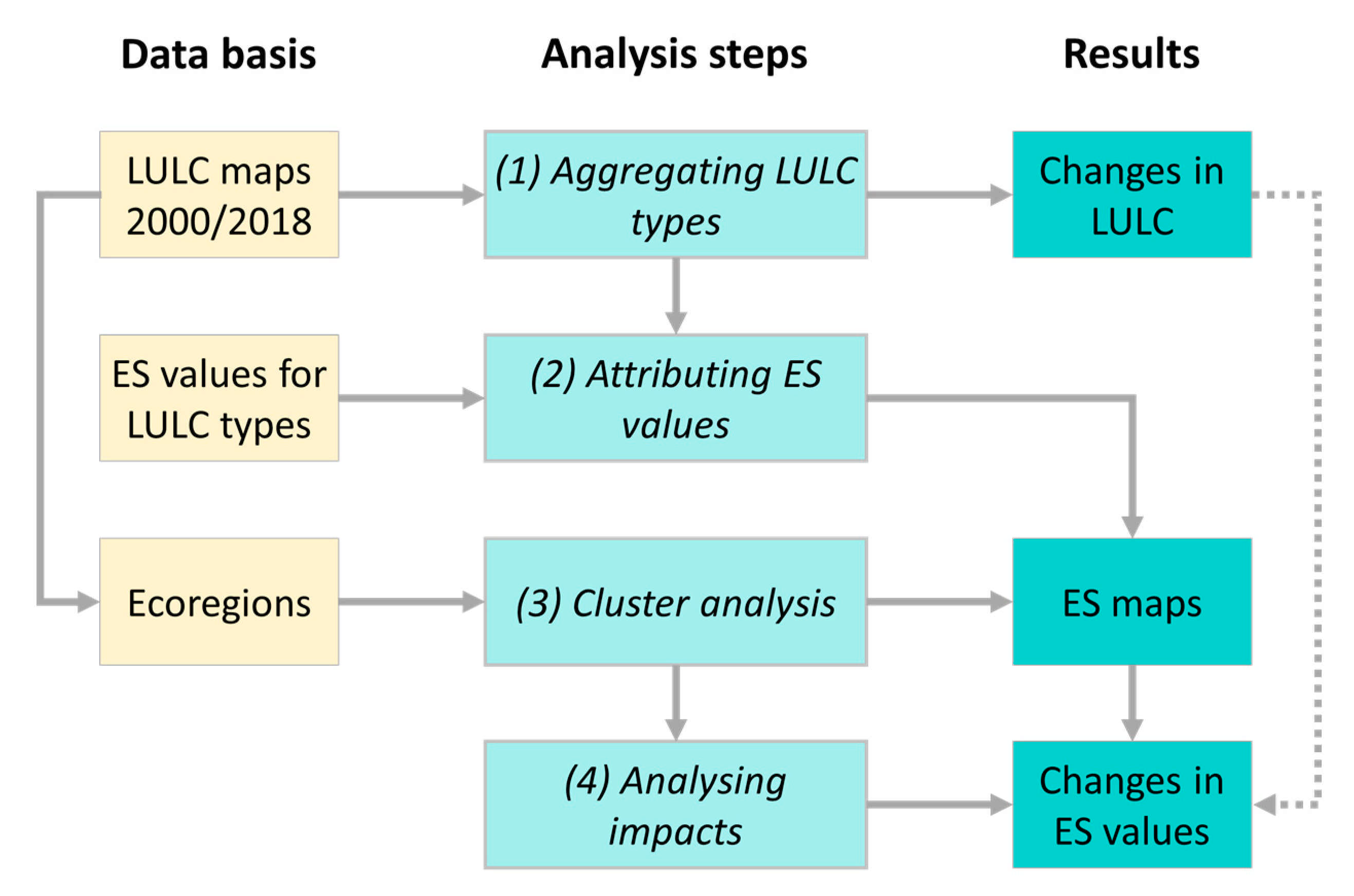

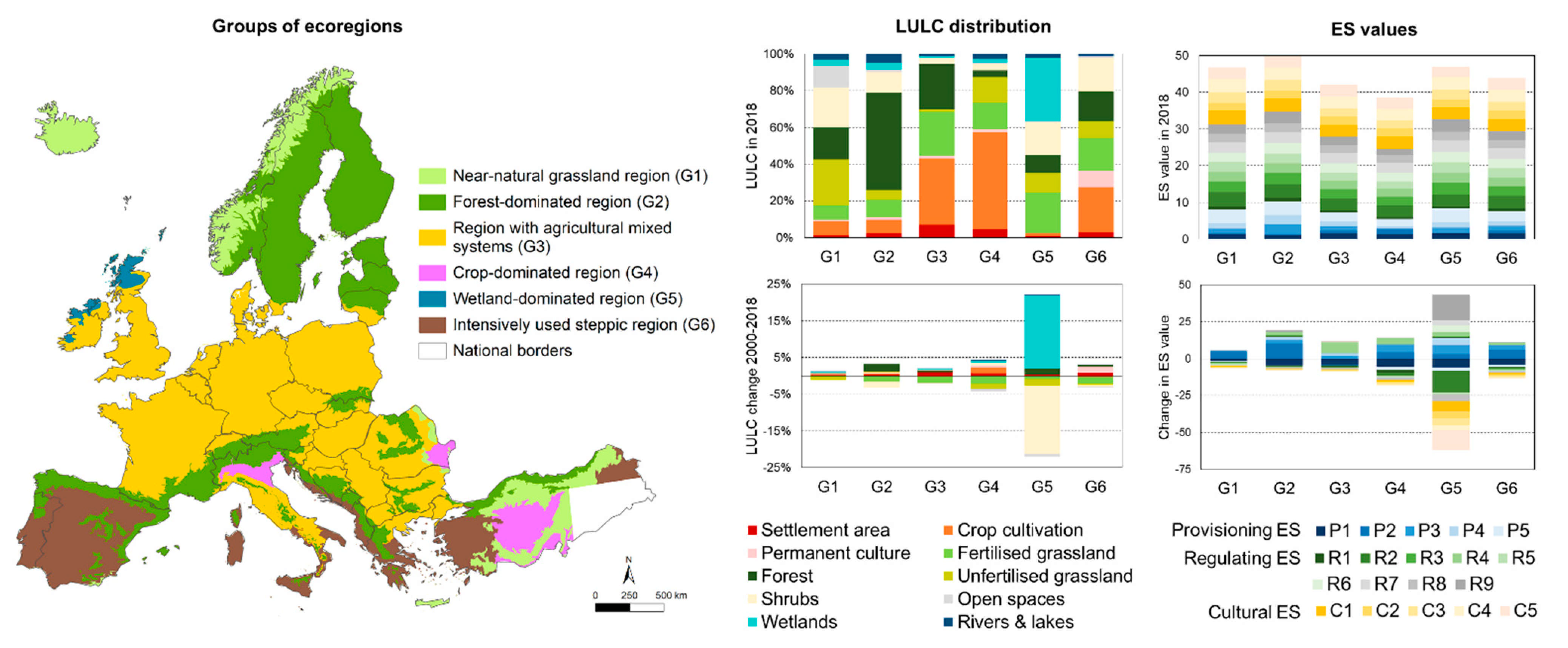
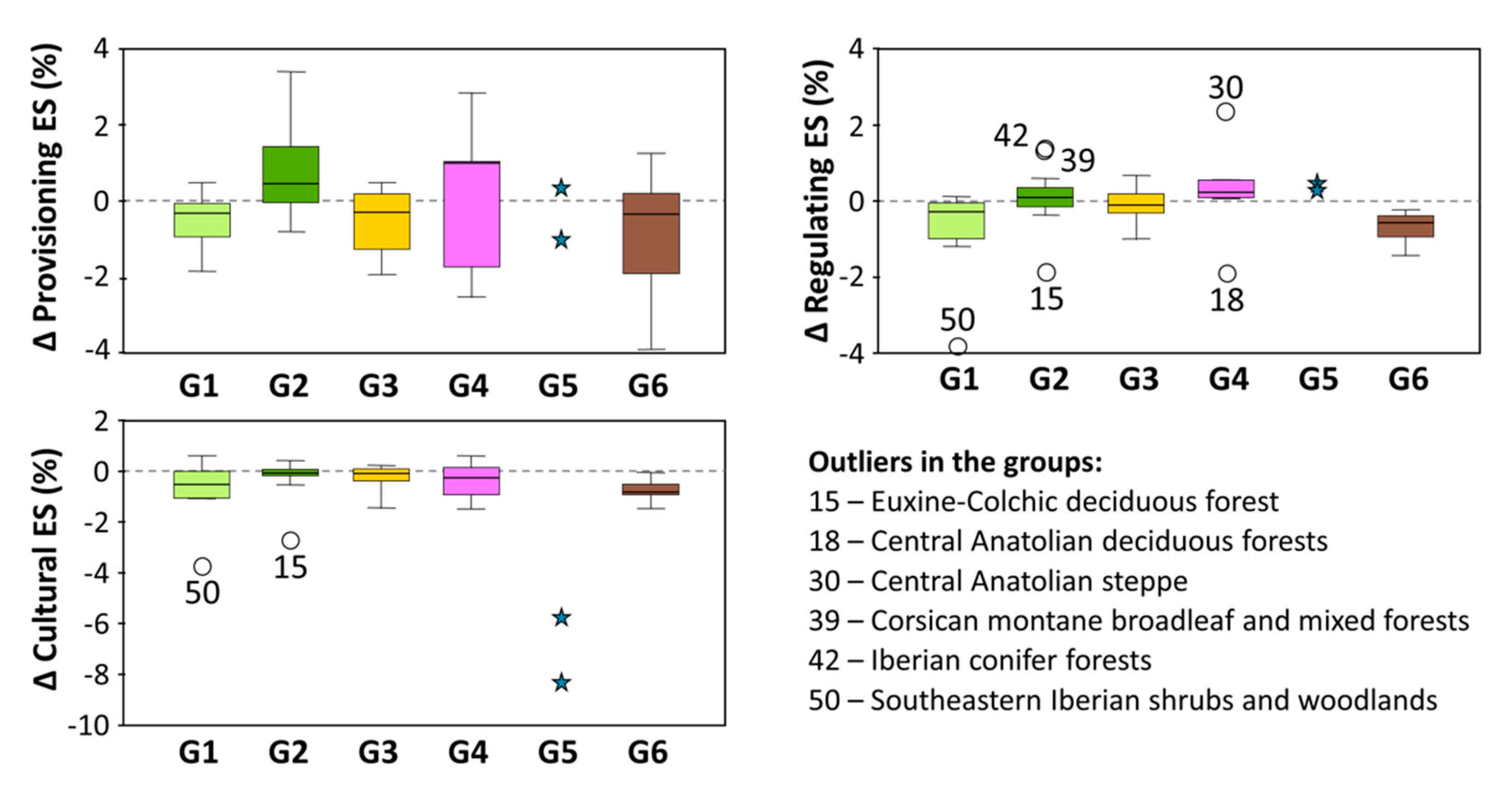
Publisher’s Note: MDPI stays neutral with regard to jurisdictional claims in published maps and institutional affiliations. |
© 2021 by the authors. Licensee MDPI, Basel, Switzerland. This article is an open access article distributed under the terms and conditions of the Creative Commons Attribution (CC BY) license (https://creativecommons.org/licenses/by/4.0/).
Share and Cite
Schirpke, U.; Tasser, E. Trends in Ecosystem Services across Europe Due to Land-Use/Cover Changes. Sustainability 2021, 13, 7095. https://doi.org/10.3390/su13137095
Schirpke U, Tasser E. Trends in Ecosystem Services across Europe Due to Land-Use/Cover Changes. Sustainability. 2021; 13(13):7095. https://doi.org/10.3390/su13137095
Chicago/Turabian StyleSchirpke, Uta, and Erich Tasser. 2021. "Trends in Ecosystem Services across Europe Due to Land-Use/Cover Changes" Sustainability 13, no. 13: 7095. https://doi.org/10.3390/su13137095
APA StyleSchirpke, U., & Tasser, E. (2021). Trends in Ecosystem Services across Europe Due to Land-Use/Cover Changes. Sustainability, 13(13), 7095. https://doi.org/10.3390/su13137095







